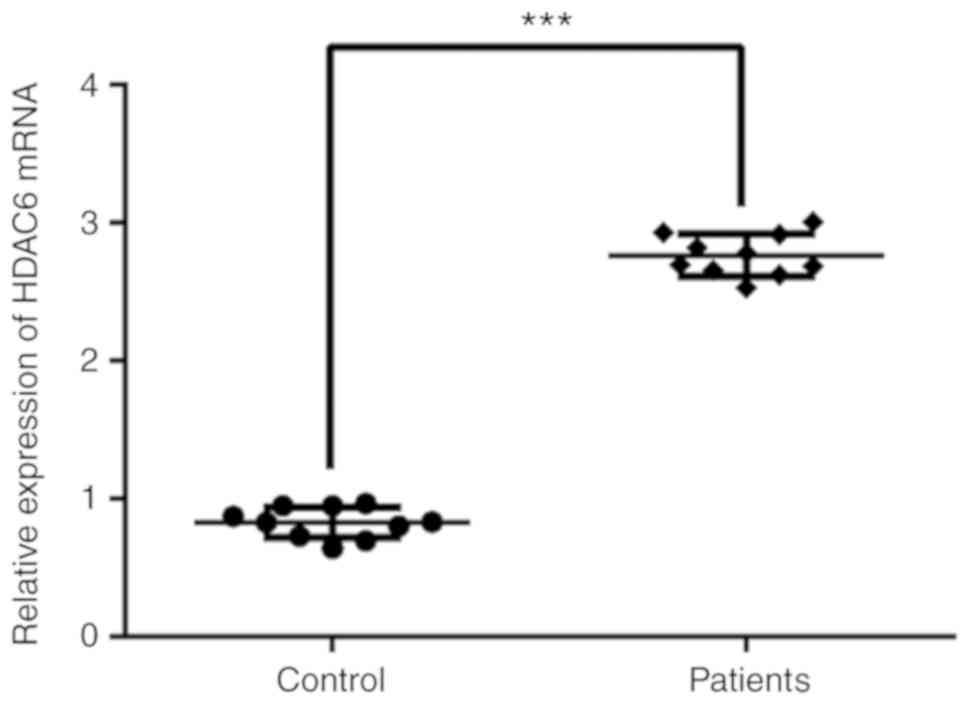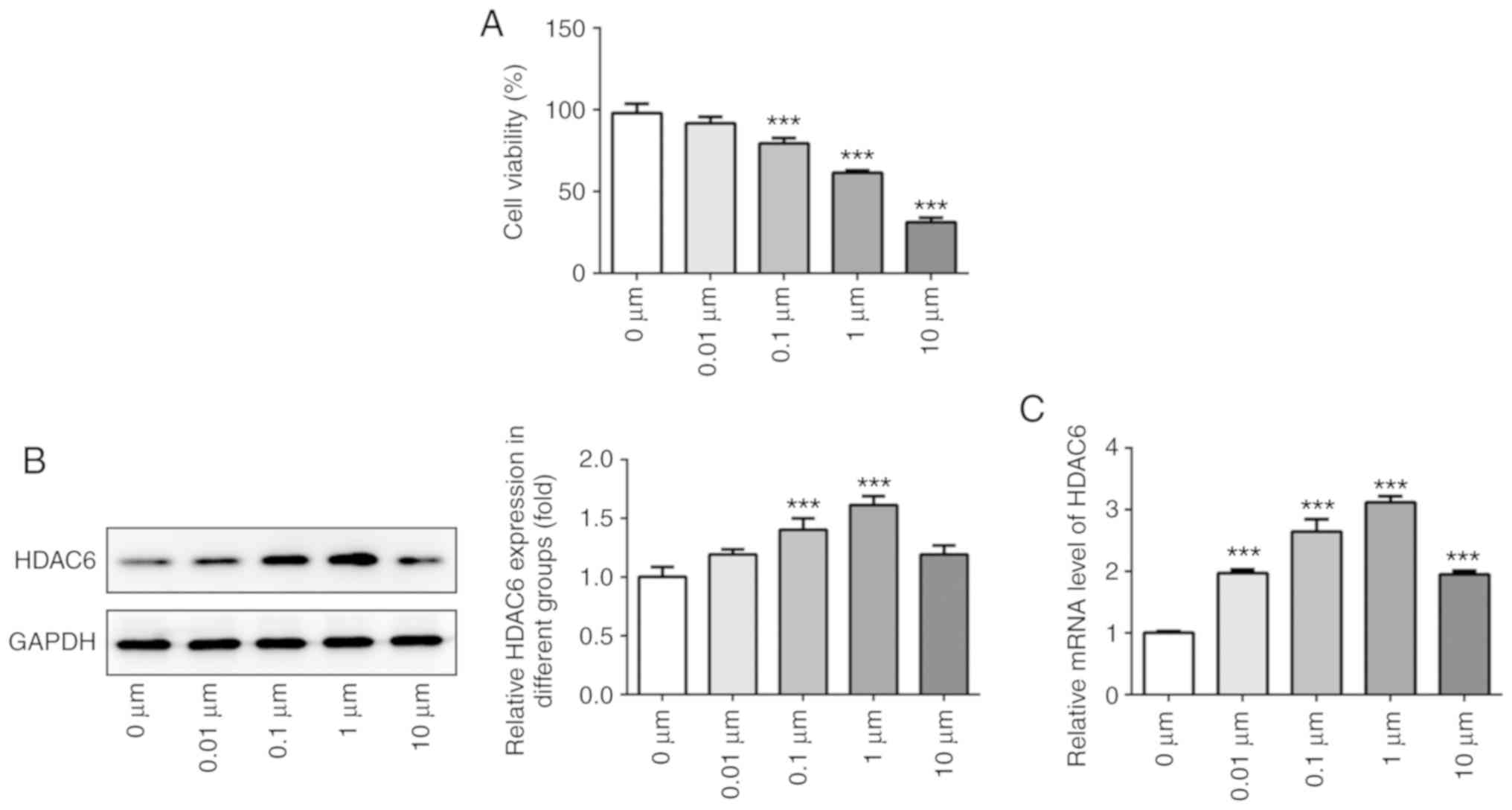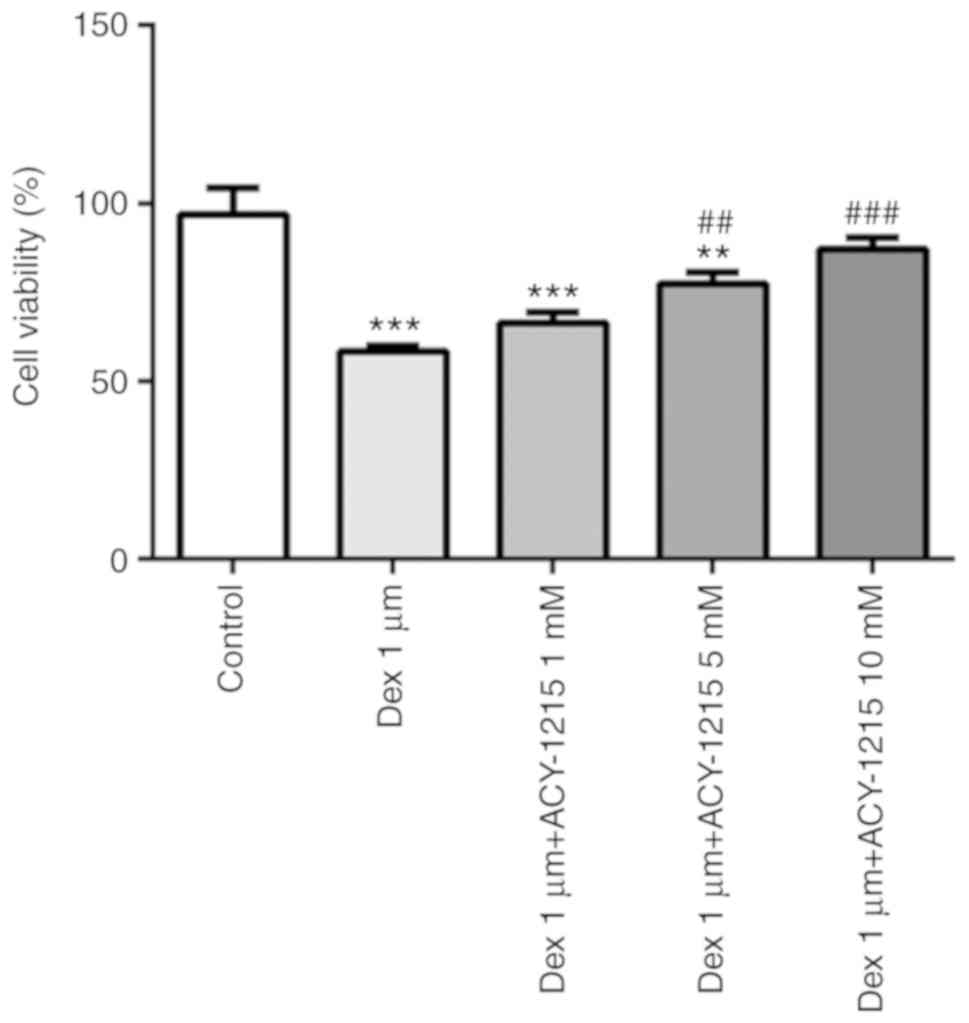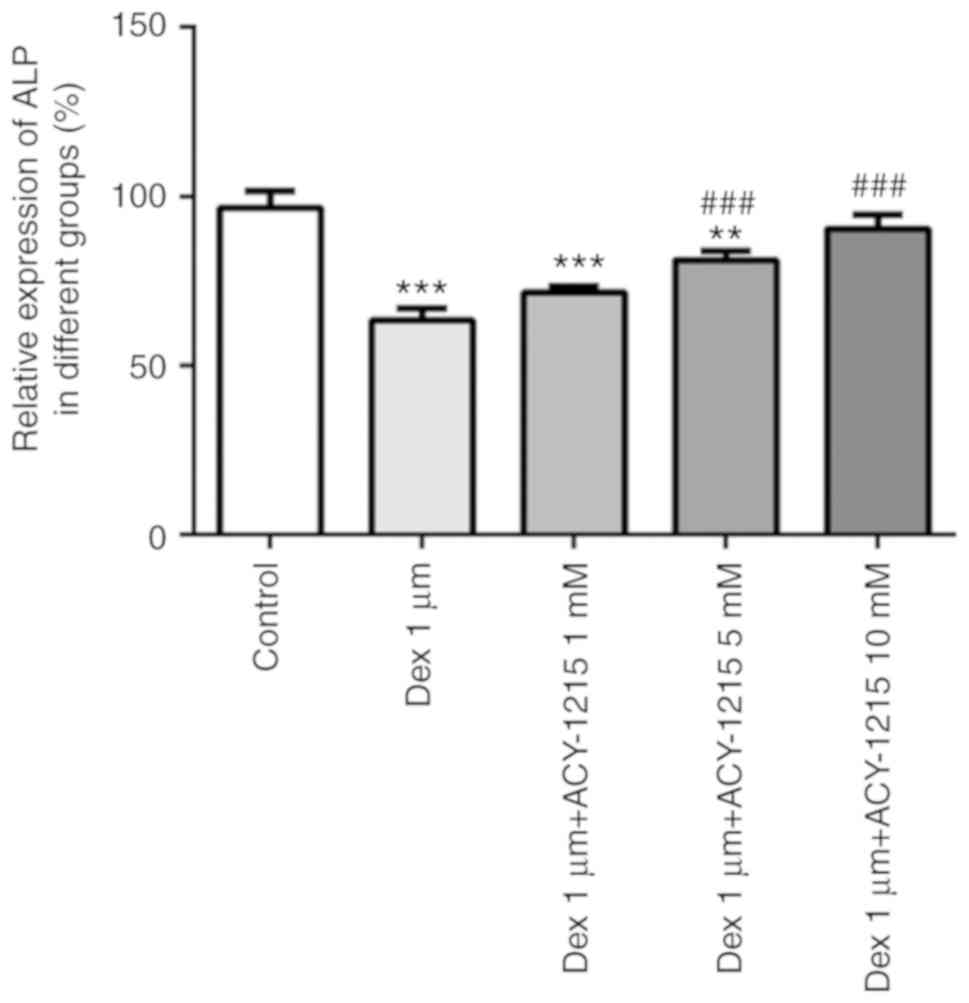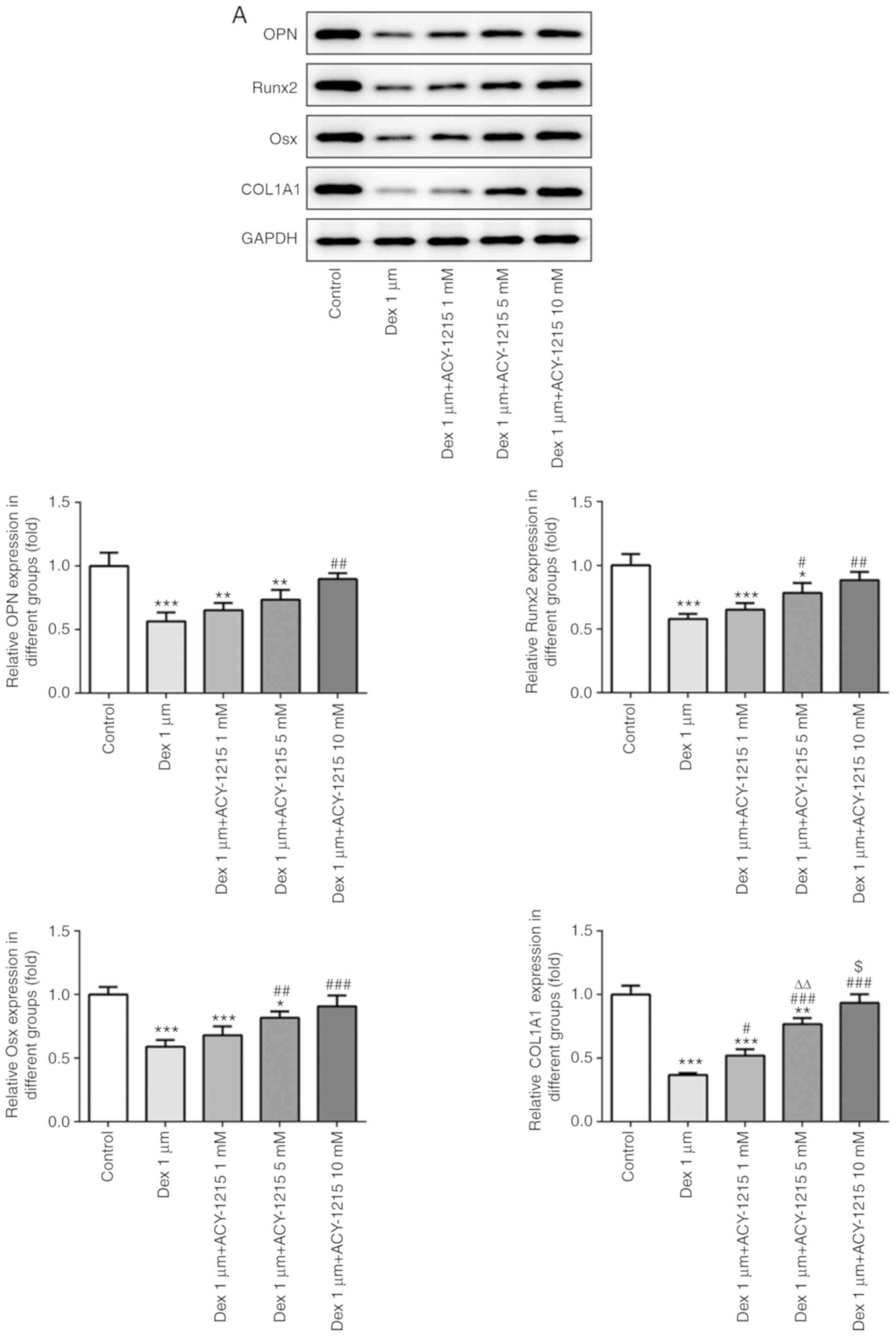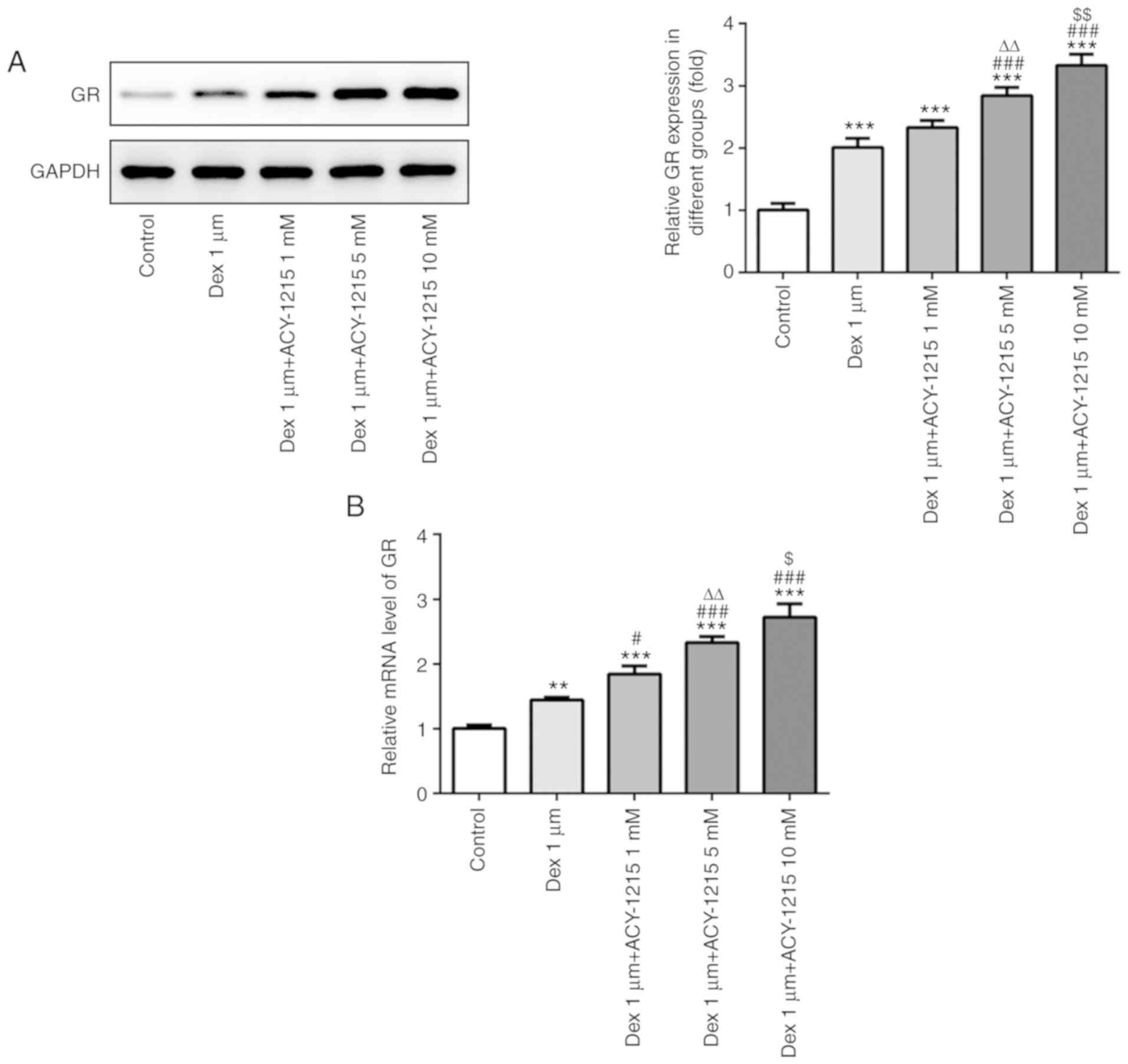ACY‑1215, a HDAC6 inhibitor, decreases the dexamethasone‑induced suppression of osteogenesis in MC3T3‑E1 cells
- Authors:
- Published online on: July 9, 2020 https://doi.org/10.3892/mmr.2020.11319
- Pages: 2451-2459
Abstract
Introduction
Secondary osteoporosis is a common type of osteoporosis in clinical practice. It is mainly secondary to diseases, including connective tissue disease or multiple myeloma, or to the use of glucocorticoids (GCs), and presents as the destruction of bone microstructure, bone loss and increased risk of fracture (1–3). GC-induced osteoporosis is the commonest secondary type of osteoporosis in clinical practice and has the highest incidence rate after postmenopausal osteoporosis and gerontological osteoporosis (3,4). Long-term administration of high doses of GCs causes increased bone absorption, decreased bone density and osteoporosis (5). A variety of rheumatology-associated diseases need to be treated with GCs, and the prevalence of secondary osteoporosis is relatively high, requiring active prevention and treatment (3). The incidence of osteoporosis in patients who have received GC treatment for >0.5 years can be 30–50% (6). In order to improve the quality of life of patients with rheumatic diseases, effective treatments for GC-induced osteoporosis are urgently required.
Histone acetylation, catalyzed by histone deacetylases (HDACs), regulates stem cell and osteoblast differentiation (7,8). HDACs are involved in the mediation of molecular signaling pathways that regulate the specification, maturation and terminal differentiation of osteoblasts (7,9,10). It has been reported that HDAC inhibitors can promote the maturation of osteoblasts (11). Reduction of HDAC1 in osteoblasts induces bone formation via upregulation of runt-related transcription factor 2 (Runx2) expression (10). HDAC6 knock-out mice exhibit a slightly increased bone mineral density, which indicates that HDAC6 is involved in bone biology (12). Furthermore, it has been demonstrated that silencing of HDAC induces the differentiation of stem cells (13–16). Long-term treatment with high doses of GCs decreases the maturity of osteoblasts, which is mediated by crosstalk between glucocorticoid receptor (GR) and HDAC6, and the GR-HDAC6 repressor complex. HDAC6 binding to GR regulates the process of dexamethasone (Dex)-induced mesenchymal stem cell differentiation into osteoblasts (17). However, the specific role of HDAC6 in Dex-induced proliferation and differentiation of preosteoblasts remains to be elucidated. Ricolinostat (ACY-1215; an HDAC6 inhibitor) has been demonstrated to reduce inflammatory damage in osteoarthritis (18). However, further studies are required to determine whether it has any effect in osteoporosis.
The present study constructed Dex-induced MC3T3-E1 cells to simulate the GC-induced osteoporosis referred to in previous studies (19–21). It aimed to explore the role of ACY-1215 in Dex-induced proliferation and differentiation of preosteoblasts to provide a basis for direct clinical treatment.
Materials and methods
Human serum samples
The present study was approved by the Human Ethics Committee Review Board of Ningbo Number 6 Hospital (Ningbo, China) and informed written consent was obtained from each patient (male/female=5/5; age, 43–65 years) and 10 healthy individuals (male/female=5/5; age, 41–62 years). Serum specimens were obtained from 10 patients with osteoporosis induced by GCs and 10 healthy individuals at Ningbo No. 6 Hospital between March 2018 and March 2019. The serum specimens were stored at −80°C prior to further experiments.
Cell culture and treatment
MC3T3-E1 cells were provided by the American Type Culture Collection. MC3T3-E1 cells were routinely cultured in 90% DMEM-H containing 10% FBS (HyClone; Cytiva) in an incubator with 5% CO2 at 37°C. The cell culture liquid was exchanged every 3 days and cells were subcultured until the cell confluence reached 80–90%. MC3T3-E1 cells were treated with various concentrations of Dex (0.01, 0.1, 1 and 10 µM) at 37°C for 24 h to select the optimal concentration of Dex. Additionally, MC3T3-E1 cells were pre-treated with various concentrations of ACY-1215 (1, 5 and 10 mM) at 37°C (14) and then treated with the optimal concentration of Dex.
Cell counting kit-8 (CCK-8) assay
MC3T3-E1 cells were collected and inoculated into 96-well plates at a density of 3×103 cells/well. Following treatment with only Dex for 24 h, or pretreatment with ACY-1215 for 2 h followed by treatment with Dex at 37°C for 24 h, MC3T3-E1 cells in each well were incubated with 10 µl CCK-8 solution at 37°C for 2 h in the dark. Finally, the absorbance value of each well was measured at a wavelength of 450 nm using a Synergy™ 2 Multi-function microplate reader (BioTek Instruments, Inc.).
Reverse transcription-quantitative (RT-q) PCR analysis
MC3T3-E1 cells were seeded into 12-well plates (3×104 cells/well). Total RNA was extracted using TRIzol® (Thermo Fisher Scientific, Inc.) and reverse transcription was performed using the Reserve Transcription System kit (Thermo Fisher Scientific, Inc.). Quantitative detection was performed using the Real-Time Fluorescence Quantitative Universal kit (DRR041A; Takara Biotechnology Co., Ltd.). The relative expression levels of HDAC6, osteopontin (OPN), Runx2, osterix (Osx), collagen I (COL1A1) and GR were detected. GAPDH was used as an internal control, and semi-quantitative analysis was performed using the 2−∆∆Cq method (22). The amplification conditions were as follows: 95°C for 10 min, followed by 40 cycles at 95°C for 10 sec and 58°C for 60 sec. The following primers were used for RT-qPCR: GAPDH forward, 5′-GCACCGTCAAGGCTGAGAAC-3′ and reverse, 5′-TGGTGAAGACGCCAGTGGA-3′; HDAC6 forward, 5′-GGAAAAGGTCGCCAGAAACTT-3′ and reverse, 5′-GGCCGGTTGAGGTCATAGTT-3′; OPN forward, 5′-AGACCTGACATCCAGTACCCTG-3′ and reverse, 5′-GTGGGTTTCAGCACTCTGGT-3′; Runx2 forward, 5′-TCCACACCATTAGGGACCATC-3′ and reverse, 5′-TGCTAATGCTTCGTGTTTCCA-3′; Osx forward, 5′-AGCGACCACTTGAGCAAACAT-3′ and reverse, 5′-GCGGCTGATTGGCTTCTTCT-3′; COL1A1 forward, 5′-CGGCTCCTGCTCCTCTTA-3′ and reverse, 5′-GGTGGGATGTCTTCGTCTT-3′; GR forward, 5′-CATTACCACAGCTCACCCCTAC-3′ and reverse, 5′-GCAATCACTTGACGCCCAC-3′. The experiment was repeated three times.
Western blot analysis
After passaging, MC3T3-E1 cells were seeded into 12-well plates (3×104 cells/well). Following pretreatment with ACY-1215 for 2 days, and treatment with Dex for 7 days, the medium was discarded and cells were lysed using RIPA buffer (Roche Applied Science) to extract protein, which was quantified using bicinchoninic acid kits. Protein (30 µg) was added to 10% SDS-PAGE gel for electrophoresis, and then electrotransferred onto nitrocellulose membranes. Following blocking of the nitrocellulose membranes with 5% skimmed milk for 2 h at room temperature, the membranes were incubated with primary antibodies against HDAC6 (cat. no. ab1440; dilution, 1:1,000; Abcam), OPN (cat. no. ab8448; dilution, 1:1,000; Abcam), Runx2 (cat. no. ab76956; dilution, 1:1,000; Abcam), Osx (cat. no. sc-393325; dilution, 1:1,000; Santa Cruz Biotechnology, Inc.), COL1A1 (cat. no. ab34710; dilution, 1:1,000; Abcam), GR (cat. no. ab3578; dilution, 1:1,000; Abcam) and GAPDH (cat. no. ab9485; dilution, 1:2,500; Abcam) overnight at 4°C. The following day, the nitrocellulose membranes were incubated with horseradish peroxidase-conjugated secondary antibody (cat. no. 7074; dilution, 1:2,000; Cell Signaling Technology, Inc.) at room temperature for 1 h. Finally, protein bands were visualized with ECL Detection reagents (Amersham; Cytiva) and the gray value of the bands was analyzed using Quantity One software (version 4.6.2; Bio-Rad Laboratories, Inc.).
Alkaline phosphatase (ALP) activity
MC3T3-E1 cells were gently washed twice with PBS, and MC3T3-E1 cells in each well were incubated with 1 ml 0.2% Triton X-100 at 4°C overnight. Using ALP assay kits (Beyotime Institute of Biotechnology), cells were mixed with 5 µl cell lysis, matrix solution and buffer per well of a 96-well plate at 37°C for 15 min. Following the addition of chromogenic agent (para-nitrophenyl phosphate) to cells at 37°C for 15 min, the absorbance value of each well was detected at a wavelength of 490 nm using a microplate reader. Additionally, standard wells and blank control wells were used. ALP activity was calculated according to the definition of enzyme activity.
Alizarin red staining
After the cells occupied 80–90% of the bottom of the culture bottle, the cells were digested and inoculated into 24-well plates at a density of 2×105 cells/well. Subsequently, 600 µl culture solution was added to each well. Following pretreatment with ACY-1215 for 2 days and treatment with Dex for 7 days, the culture medium was discarded. MC3T3-E1 cells were washed with PBS three times, fixed with 10% formaldehyde for 10 min at 4°C and washed with distilled water three times. Subsequently, 500 µl 0.1% alizarin red dye was added to each well and incubated at 37°C for 30 min. Finally, MC3T3-E1 cells were washed with distilled water three times and incubated with PBS at 37°C for 10 min. The stained samples were observed using an inverted fluorescence microscope (magnification, ×200).
Statistical analysis
SPSS v22.0 statistical software (IBM Corp.) was used to analyze the data, and the measurement data are presented as the mean ± standard deviation. A t-test was used for comparisons between two groups, and one-way analysis of variance with Tukey's post hoc test was used for comparisons among multiple groups. P<0.05 was considered to indicate a statistically significant difference.
Results
HDAC6 expression in the serum of patients with GC-induced osteoporosis
The expression levels of HDAC6 in the serum of patients with GC-induced osteoporosis were determined by RT-qPCR analysis (Fig. 1). HDAC6 serum expression was significantly increased in patients with GC-induced osteoporosis compared with healthy individuals (control).
Dex promotes HDAC6 expression in osteoblast MC3T3-E1 cells
MC3T3-E1 cells were treated with Dex at various concentrations for 24 h. Cell viability was gradually decreased with increasing Dex concentration (Fig. 2A). HDAC6 expression was gradually upregulated in MC3T3-E1 cells treated with 0–1 µM Dex, whereas HDAC6 expression was decreased in MC3T3-E1 cells treated with 10 µM Dex (Fig. 2B and C). Therefore, 1 µM Dex was selected for the following experiments.
ACY-1215 decreases the effect of Dex on cell viability
MC3T3-E1 cells were pre-treated with ACY-1215 (1, 5 and 10 mM) for 2 h, and then treated with 1 µM Dex for 24 h. The treatment of MC3T3-E1 cells with 1 µM Dex suppressed the cell viability, and this was reversed by treatment with ACY-1215 (1, 5 and 10 mM; Fig. 3).
ACY-1215 decreases the Dex-induced suppression of ALP activity in osteoblast MC3T3-E1 cells
MC3T3-E1 cells were treated with ACY-1215 and Dex as aforementioned. After 7 days, ALP activity was significantly decreased in the Dex group. When ACY-1215 (1, 5 and 10 mM) was used to treat MC3T3-E1 cells treated with Dex, ALP activity was increased in a concentration-dependent manner (Fig. 4).
ACY-1215 decreases the Dex-induced suppression of the capacity for mineralization of osteoblast MC3T3-E1 cells
Following treatment of MC3T3-E1 cells with ACY-1215 and Dex for 7 days, mineralization was impaired in the Dex group compared with the control group. However, following pretreatment with ACY-1215 (1, 5 and 10 mM), mineralization was enhanced in MC3T3-E1 cells treated with Dex (Fig. 5).
ACY-1215 decreases the Dex-induced suppression of osteogenesis of osteoblast MC3T3-E1 cells
Following treatment of MC3T3-E1 cells with ACY-1215 and Dex for 7 days, the protein and mRNA expression levels of mineralization-associated proteins were detected by western blotting and RT-qPCR. As revealed in Fig. 6A and B, the protein and mRNA expression levels of OPN, Runx2, Osx and COL1A1 were decreased in MC3T3-E1 cells treated with Dex. Increasing concentrations of ACY-1215 reversed the inhibitory effect of Dex and increased the protein and mRNA expression levels of OPN, Runx2, Osx and COL1A1 in MC3T3-E1 cells treated with Dex.
ACY-1215 regulates the expression levels of GR in osteoblast MC3T3-E1 cells
Following treatment of MC3T3-E1 cells with ACY-1215 and Dex for 7 days, the protein and mRNA expression levels of GR were analyzed by western blotting and RT-qPCR. As revealed in Fig. 7A and B, Dex (1 µM) treatment increased GR receptor expression and ACY-1215 with increasing concentrations of 1 to 10 mM gradually further increased the expression of GR receptor.
Discussion
The present study investigated the effect of ACY-1215 on the proliferation and differentiation of MC3T3-E1 cells treated with Dex. The results indicated that ACY-1215 reversed the inhibitory effect of Dex on the proliferation and differentiation of MC3T3-E1 cells.
HDAC6 is closely associated with ubiquitination imbalance, microtubulin deficiency and oxidative stress, and it also serves an important regulatory role in the occurrence and development of ovarian, breast, esophageal and gastric cancers (23). Additionally, HDAC6 has a function in bone diseases. Li et al (24) revealed that HDAC6 activity was increased following high-dose silicate treatment, and HDAC6 inhibition could protect bone mesenchymal stem cells by improving the microtubule structure and autophagic activity. Wang et al (25) indicated that HDAC6 knockdown promoted ALP activity and mineralized nodule formation in dental mesenchymal stem cells. In an achondroplasia model, HDAC6 inhibition and the HDAC6 inhibitor tubacin promoted endochondral bone growth by decreasing fibroblast growth factor receptor 3 accumulation (26). HDAC6 has been revealed to be overexpressed in osteoarthritis, and ACY-1215 treatment to promote apoptosis of osteoarthritis osteoblasts and inhibit aberrant subchondral bone formation (27). In the present study, HDAC6 expression was increased in patients with GC-induced osteoporosis and MC3T3-E1 cells treated with Dex. Additionally, HDAC6 inhibition could promote the viability, mineralization and osteogenesis of MC3T3-E1 cells. Overall, HDAC6 inhibition could effectively improve ALP activity and mineralized nodule formation, which was also demonstrated in the present study.
GR has multiple effects on osteocytes in osteoporosis; however, these have been only rarely investigated (28). Plotkin et al (29) demonstrated that GCs mediate the apoptosis of bone cells via GR. In vitro, high doses of GCs could inhibit the formation of osteoclasts through GR in osteoblasts and osteoclasts (30). Furthermore, Kim et al (31) observed that Dex inhibited osteoclast formation and proliferation depending on GR in osteoclasts. HPOB, an HDAC6 inhibitor, alleviated corticosterone-induced injury in PC12 cells by suppressing GR translocation (32). In the present study, GR expression was upregulated in MC3T3-E1 cells treated with Dex. Furthermore, ACY-1215 promoted GR expression, and improved the viability, mineralization and osteogenesis of MC3T3-E1 cells. The prolonged use of glucocorticoids could lead to decreased expression level of the GR gene, which leads to GC resistance (33). In the present study, the expression of GR gradually increased with pretreatment by ACY-1215. It was hypothesized that ACY-1215 may recruit GR receptors to decrease the number of GR receptors combined with DEX, inhibiting the role of DEX and thereby improving the growth of MC3T3-E1 cells. The underlying mechanism of the proliferation promoting effect of ACY-1215 on Dex-induced MC3T3-E1 cells related to GR receptors requires further investigation.
Previous studies have demonstrated the role of HDAC6 in regulating GR. For example, HDAC6 can cause deacetylation of heat shock protein 90, which is crucial for GR chaperone activity, ligand binding, translocation and gene activation (34–36). When mesenchymal stromal cells (MSCs) are treated with Dex, HDAC6 translocates to the nucleus in a similar way to GR and the complex of HDAC6 and GR is formed on the third day of osteogenic induction. When MSCs are treated with high concentrations of Dex, the GR-HDAC6 complex is weakened, although it is not completely absent. This could either be explained by partial degradation of GR following prolonged treatment with high concentrations of Dex or a decrease in HDAC6 protein expression. In the presence of RU-486 (GR inhibitor), HDAC6 expression in MSCs is decreased which indicates that GR could regulate HDAC6 expression. In addition, tubacin (HDAC6 inhibitor) can weaken the complex formation between GR and HDAC6 (18). The association between HDAC6 and GR in the pathogenesis of GC-induced secondary osteoporosis will be investigated in a future study.
In conclusion, HDAC6 expression was upregulated in serum samples of patients with osteoporosis and MC3T3-E1 cells treated with Dex at a certain concentration range (0.01–1 µm). ACY-1215 treatment improved the cell viability, ALP activity, mineralization capacity and osteogenesis of MC3T3-E1 cells treated with Dex. Additionally, ACY-1215 increased the expression levels of GR in MC3T3-E1 cells treated with Dex. However, there were limitations in the present study. Studying the effect of ACY-1215 on osteoclastogenesis would render the research more complete. It is hoped to perform experiments to explore the effect of ACY-1215 on osteoclastogenesis in the future.
Acknowledgements
Not applicable.
Funding
The present study was supported by the Zhejiang Medical and Health Research Project (grant no. 2018KY722).
Availability of data and materials
The datasets used and/or analyzed during the current study are available from the corresponding author on reasonable request.
Authors' contributions
HW and JC contributed to the conception and design of the study. NW performed the experiments and wrote the manuscript. FW, SW, QZ and QY helped perform the experiments. SH, PW and FY analyzed and interpreted the data. HW and JC critically revised the manuscript. All authors read and approved the final manuscript.
Ethics approval and consent to participate
The present study was approved by the Human Ethics Committee Review Board of Ningbo Number 6 Hospital (Ningbo, China), and informed written consent was obtained from each patient.
Patient consent for publication
Not applicable.
Competing interests
The authors declare that they have no competing interests.
References
|
Mirza F and Canalis E: Management of endocrine disease: Secondary osteoporosis: Pathophysiology and management. Eur J Endocrinol. 173:R131–R151. 2015. View Article : Google Scholar : PubMed/NCBI | |
|
Sheu A and Diamond T: Secondary osteoporosis. Aust Prescr. 39:85–87. 2016.PubMed/NCBI | |
|
Colangelo L, Biamonte F, Pepe J, Cipriani C and Minisola S: Understanding and managing secondary osteoporosis. Expert Rev Endocrinol Metab. 14:111–122. 2019. View Article : Google Scholar : PubMed/NCBI | |
|
Rooney M, Bishop N, Davidson J, Beresford MW, Pilkington C, Donagh JM, Wyatt S, Gardner-Medwin J, Satyapal R, Clinch J, et al: The prevention and treatment of glucocorticoid-induced osteopaenia in juvenile rheumatic disease: A randomised double-blind controlled trial. EClinicalMedicine. 12:79–87. 2019. View Article : Google Scholar : PubMed/NCBI | |
|
Caplan L and Saag KG: Glucocorticoids and the risk of osteoporosis. Expert Opin Drug Saf. 8:33–47. 2009. View Article : Google Scholar : PubMed/NCBI | |
|
Buckley L, Guyatt G, Fink HA, Cannon M, Grossman J, Hansen KE, Humphrey MB, Lane NE, Magrey M, Miller M, et al: 2017 American college of rheumatology guideline for the prevention and treatment of glucocorticoid-induced osteoporosis. Arthritis Rheumatol. 69:1521–1537. 2017. View Article : Google Scholar : PubMed/NCBI | |
|
McGee-Lawrence ME and Westendorf JJ: Histone deacetylases in skeletal development and bone mass maintenance. Gene. 474:1–11. 2011. View Article : Google Scholar : PubMed/NCBI | |
|
Westendorf JJ: Histone deacetylases in control of skeletogenesis. J Cell Biochem. 102:332–340. 2007. View Article : Google Scholar : PubMed/NCBI | |
|
Jensen ED, Schroeder TM, Bailey J, Gopalakrishnan R and Westendorf JJ: Histone deacetylase 7 associates with Runx2 and represses its activity during osteoblast maturation in a deacetylation-independent manner. J Bone Miner Res. 23:361–372. 2008. View Article : Google Scholar : PubMed/NCBI | |
|
Lee HW, Suh JH, Kim AY, Lee YS, Park SY and Kim JB: Histone deacetylase 1-mediated histone modification regulates osteoblast differentiation. Mol Endocrinol. 20:2432–2443. 2006. View Article : Google Scholar : PubMed/NCBI | |
|
Schroeder TM and Westendorf JJ: Histone deacetylase inhibitors promote osteoblast maturation. J Bone Miner Res. 20:2254–2263. 2005. View Article : Google Scholar : PubMed/NCBI | |
|
Zhang Y, Kwon S, Yamaguchi T, Cubizolles F, Rousseaux S, Kneissel M, Cao C, Li N, Cheng HL, Chua K, et al: Mice lacking histone deacetylase 6 have hyperacetylated tubulin but are viable and develop normally. Mol Cell Biol. 28:1688–1701. 2008. View Article : Google Scholar : PubMed/NCBI | |
|
Dudakovic A, Evans JM, Li Y, Middha S, McGee-Lawrence ME, van Wijnen AJ and Westendorf JJ: Histone deacetylase inhibition promotes osteoblast maturation by altering the histone H4 epigenome and reduces Akt phosphorylation. J Biol Chem. 288:28783–28791. 2013. View Article : Google Scholar : PubMed/NCBI | |
|
Eslaminejad MB, Fani N and Shahhoseini M: Epigenetic regulation of osteogenic and chondrogenic differentiation of mesenchymal stem cells in culture. Cell J. 15:1–10. 2013.PubMed/NCBI | |
|
Kretsovali A, Hadjimichael C and Charmpilas N: Histone deacetylase inhibitors in cell pluripotency, differentiation, and reprogramming. Stem Cells Int. 2012:1841542012. View Article : Google Scholar : PubMed/NCBI | |
|
Menegola E, Di Renzo F, Broccia ML and Giavini E: Inhibition of histone deacetylase as a new mechanism of teratogenesis. Birth Defects Res C Embryo Today. 78:345–353. 2006. View Article : Google Scholar : PubMed/NCBI | |
|
Rimando MG, Wu HH, Liu YA, Lee CW, Kuo SW, Lo YP, Tseng KF, Liu YS and Lee OK: Glucocorticoid receptor and Histone deacetylase 6 mediate the differential effect of dexamethasone during osteogenesis of mesenchymal stromal cells (MSCs). Sci Rep. 6:373712016. View Article : Google Scholar : PubMed/NCBI | |
|
Cheng C, Shan W, Huang W, Ding Z, Cui G, Liu F, Lu W, Xu J, He W and Yin Z: ACY-1215 exhibits anti-inflammatory and chondroprotective effects in human osteoarthritis chondrocytes via inhibition of STAT3 and NF-κB signaling pathways. Biomed Pharmacother. 109:2464–2471. 2019. View Article : Google Scholar : PubMed/NCBI | |
|
Xing L, Zhang X, Feng H, Liu S, Li D, Hasegawa T, Guo J and Li M: Silencing FOXO1 attenuates dexamethasone-induced apoptosis in osteoblastic MC3T3-E1 cells. Biochem Biophys Res Commun. 513:1019–1026. 2019. View Article : Google Scholar : PubMed/NCBI | |
|
Li S, Jiang H and Gu X: Echinacoside suppresses dexamethasone-induced growth inhibition and apoptosis in osteoblastic MC3T3-E1 cells. Exp Ther Med. 16:643–648. 2018.PubMed/NCBI | |
|
Han D, Gu X, Gao J, Wang Z, Liu G, Barkema HW and Han B: Chlorogenic acid promotes the Nrf2/HO-1 anti-oxidative pathway by activating p21 Waf1/Cip1 to resist dexamethasone-induced apoptosis in osteoblastic cells. Free Radic Biol Med. 137:1–12. 2019. View Article : Google Scholar : PubMed/NCBI | |
|
Livak KJ and Schmittgen TD: Analysis of relative gene expression data using real-time quantitative PCR and the 2(-Delta Delta C(T)) method. Methods. 25:402–408. 2001. View Article : Google Scholar : PubMed/NCBI | |
|
Chen HT, Liu H, Mao MJ, Tan Y, Mo XQ, Meng XJ, Cao MT, Zhong CY, Liu Y, Shan H and Jiang GM: Crosstalk between autophagy and epithelial-mesenchymal transition and its application in cancer therapy. Mol Cancer. 18:1012019. View Article : Google Scholar : PubMed/NCBI | |
|
Li Z, Liu S, Fu T, Peng Y and Zhang J: Microtubule destabilization caused by silicate via HDAC6 activation contributes to autophagic dysfunction in bone mesenchymal stem cells. Stem Cell Res Ther. 10:3512019. View Article : Google Scholar : PubMed/NCBI | |
|
Wang Y, Shi ZY, Feng J and Cao JK: HDAC6 regulates dental mesenchymal stem cells and osteoclast differentiation. BMC Oral Health. 18:1902018. View Article : Google Scholar : PubMed/NCBI | |
|
Ota S, Zhou ZQ, Romero MP, Yang G and Hurlin PJ: HDAC6 deficiency or inhibition blocks FGFR3 accumulation and improves bone growth in a model of achondroplasia. Hum Mol Genet. 25:4227–4243. 2016. View Article : Google Scholar : PubMed/NCBI | |
|
Li L, Liu F, Huang W, Wang J, Wan YP, Li M, Pang YQ and Yin ZS: Ricolinostat (ACY-1215) inhibits VEGF expression via PI3K/AKT pathway and promotes apoptosis in osteoarthritic osteoblasts. Biomed Pharmacother. 118:1093572019. View Article : Google Scholar : PubMed/NCBI | |
|
Komori T: Regulation of skeletal development by the Runx family transcription factors. J Cell Biochem. 95:445–453. 2005. View Article : Google Scholar : PubMed/NCBI | |
|
Plotkin L, Manolagas S and Bellido T: Glucocorticoids induce osteocyte apoptosis by blocking focal adhesion kinase-mediated survival. Evidence for inside-out signaling leading to anoikis. J Biol Chem. 282:24120–24130. 2007. View Article : Google Scholar : PubMed/NCBI | |
|
Rauch A, Seitz S, Baschant U, Schilling AF, Illing A, Stride B, Kirilov M, Mandic V, Takacz A, schmidt-ullrich R, et al: Glucocorticoids suppress bone formation by attenuating osteoblast differentiation via the monomeric glucocorticoid receptor. Cell Metab. 11:517–531. 2010. View Article : Google Scholar : PubMed/NCBI | |
|
Kim HJ, Zhao H, Kitaura H, Bhattacharyya S, Brewer JA, Muglia LJ, Ross FP and Teitelbaum SL: Glucocorticoids suppress bone formation via the osteoclast. J Clin Invest. 116:2152–2160. 2006. View Article : Google Scholar : PubMed/NCBI | |
|
Li ZY, Li QZ, Chen L, Chen BD, Zhang C, Wang X and Li WP: HPOB, an HDAC6 inhibitor, attenuates corticosterone-induced injury in rat adrenal pheochromocytoma PC12 cells by inhibiting mitochondrial GR translocation and the intrinsic apoptosis pathway. Neurochem Int. 99:239–251. 2016. View Article : Google Scholar : PubMed/NCBI | |
|
Li RJ and Liu J: Pharmacogenetics advances of glucocorticoid resistance and polymorphism of glucocorticoid receptor. Chin J New Drugs. 24:1246–1254. 2015. | |
|
Vandevyver S, Dejager L and Libert C: On the trail of the glucocorticoid receptor: Into the nucleus and back. Traffic. 13:364–374. 2012. View Article : Google Scholar : PubMed/NCBI | |
|
Kovacs JJ, Murphy PJ, Gaillard S, Zhao X, Wu JT, Nicchitta CV, Yoshida M, Toft DO, Pratt WB and Yao TP: HDAC6 regulates Hsp90 acetylation and chaperone-dependent activation of glucocorticoid receptor. Mol Cell. 18:601–607. 2005. View Article : Google Scholar : PubMed/NCBI | |
|
Espallergues J, Teegarden SL, Veerakumar A, Boulden J, Challis C, Jochems J, Chan M, Petersen T, Deneris E, Matthias P, et al: HDAC6 regulates glucocorticoid receptor signaling in serotonin pathways with critical impact on stress resilience. J Neurosci. 32:4400–4416. 2012. View Article : Google Scholar : PubMed/NCBI |



